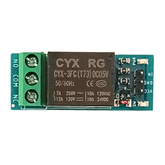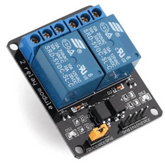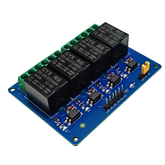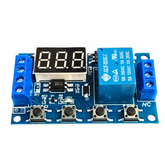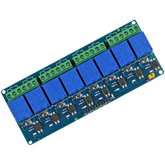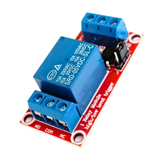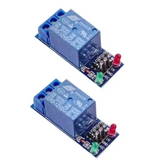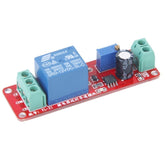Working Principle of Relays
Summary
Discover the heartbeat of electronic circuits in our latest blog, "Working Principle of Relays." Delve into the intricate world of relays as we unveil their significance in electronic systems. Explore the key components and their vital functions, unraveling the mystery behind these unsung heroes. Uncover the core working principles that make relays indispensable. Don't miss the chance to enhance your understanding of this crucial technology. Join us on this electrifying journey from introduction to conclusion, where every click sparks newfound knowledge. Ignite your curiosity and click to enlighten your electronic insights!
What is Relay?
A relay is a device used to control the flow of electrical power in industrial or domestic applications. It allows one circuit to be connected with another, without direct contact between them. A relay consists of an electromagnet that when energized creates a magnetic field which activates mechanical contacts within the unit allowing electricity to turn on and off as needed according to pre-defined settings.
Relays have become vital components in modern day electronic systems such as automotive engine management, HVAC equipment control and lights controlling for energy savings among many others. They provide flexibility for changing requirements while ensuring safety by switching off current under fault conditions preventing damage from overloading circuits or shorting out wires thus providing fail safe protection during operation making it virtually indispensable part any industry today!
Find out What is Relay and its importance.

Importance of Relays in Electronic Circuits
A relay is a device used to control the flow of electrical power in industrial or domestic applications. It allows one circuit to be connected with another, without direct contact between them.
A relay consists of an electromagnet that when energized creates a magnetic field which activates mechanical contacts within the unit allowing electricity to turn on and off as needed according to pre-defined settings. Relays have become vital components in modern day electronic systems such as automotive engine management, HVAC equipment control and lights controlling for energy savings among many others.
They provide flexibility for changing requirements while ensuring safety by switching off current under fault conditions preventing damage from overloading circuits or shorting out wires thus providing fail safe protection during operation making it virtually indispensable part any industry today!
How Relays control high-voltage devices – Explained.
Components and Their Functions
A relay is an essential component of electrical circuits. As a key switching device, it can be used to switch on and off current flowing through different points in the circuit, allowing for better control over how energy flows. The main components of a typical relay include: an electromagnet core or frame that provides mechanical support; contact switches where connections are made between two power supplies; insulation material which ensures there will not be any unwanted voltage leaps across contacts; braid cables that transfer electric signals from one point in the system to another; strain relief clamps protecting wires from wear and tear due to frequent bending motions caused by machinery movement during operation.
Additionally, these relays may also have other accessories such as brackets helping with installation within certain systems or coils providing enough magnetic force for proper connection when necessary tasks need activating or deactivating. All these elements work together ensuring reliable performance while keeping safety standards high at all times Providing superior quality propels many industries forward every day making them more efficient thanks to this crucial part's role in their operations A relay is an essential component in any electrical system, consisting of a coil and several sets of contacts. The coil receives power from another source before releasing it to activate the rest of the components. Relays are designed for convenience and economy when controlling high voltages or currents that would otherwise require large amperage switches.

The first part, known as the Contact armature, is responsible for opening and closing contact points by responding to signals from other circuit elements like switches or timers; this allows different parts of the circuit to communicate with each other without having direct physical connections between them.
Next comes Coil Winding which stores energy in a magnetic field created by its current flow - allowing polarity reversal switching through control over ground potentials within circuits while also providing galvanic isolation protection against overload/spike risk opportunities faced during operation period at continuous intervals throughout time.
Finally there’s Ground Terminal ensuring tightness & uninterruptible performance via fine-tuned low ohmic value pathways whilst simultaneously proving strong anti EMI capabilities due resistance towards disruptive forces such as environmental noise disturbances experienced during transmission process across wires involved alongside main line Y shape capability making single pole connection possible on both ends thereby bypassing complicated 6 wire voltage path depriving most chances taken up by rudimentary interference setting further apart any chance arisen caused unintended wiring form disastrous consequences had encountered established fault lines moving forward uninterruptedly ahead.
Working Principle of Relays
The electromagnetic attraction principle of a relay is an important concept in modern day technology. In essence, the process involves using a magnetic field to attract and move contacts within the switching apparatus. This physical movement serves as an indication that current has been detected in one location or another and triggers further action like opening or closing circuits to send signals from point A to B.
Relays are known for their reliability due to this basic interaction between magnetism and power but also for providing secure insulation when used correctly within electrical systems where it can act as protection against over heating potentials caused by short-circuits etcetera The effect works because magnets draw objects via lines of force which tightly bind them together even if there's some distance between them - thus making the contact operation frictionless irrespective of any gearbox requirements etc., proving itself invaluable across numerous industries such engineering, robotics, automotive applications manufacturing processes among others please seek qualified advice before applying these principles yourself! The coil and armature of a relay are essential components that work together to activate the device.
The coil is an electromagnet made up of several turns, or windings, of insulated copper wire wrapped around a metal core. When current flows through the coils winding it generates magnetic field which causes movement in the internal parts known as induction. This force then actuates on contacts within the device resulting in its operation leading to switching ON/OFF different circuits connected load side for desired application purpose & activating another extra circuit if required after primary control command received from external source controlling signal input port activated by controller let’s say PLC involving timer setting with other devices interlocking parameter configuration done under supervision during programmable logic controllers (PLC) system set-up process upon installation at jobsite premises executed successfully completing along with all necessary cables including power supplies being interconnected properly prior towards energized units finally ready deliver fully operational state achievable.
Relay operation is an important part of many industrial processes and has been used in the electrical industry for nearly two centuries. Relays are responsible for switching electric signals on and off, which allows a variety of control mechanisms to be implemented – from simple flickering lights to sophisticated automated systems controlling entire production lines. In countless scenarios around the world they remain essential components within these operations both as safety interlock (e-stop) or fail safe devices as well as general power/supply disclosure relays; all with their own unique operating criteria and specifications depending upon application details such telecommunication standards, wire length requirements, output voltage etc.
To maximize performance it’s highly recommended that customers select quality equipment designed specifically for purpose - capable switch modules requiring minimal maintenance can save significant costs further down line. Beyond construction & installation factors surrounding environmental aspects should also form integral considerations when assessing overall suitability: matters like temperature ratings need to noted alongside vibration mitigation elements i.e mounting type / isolation design if system contains resonant frequencies outside target range then future issues may result thus suitable insulating coatings must carefully considered prior purchase evaluation too.
Also, read our blog on Applications of Relay explaining 8 major applications, what is it, how does it works, its construction, and different types of relays.
Conclusion:
Delving into the intricate realm of relays has unveiled their paramount role in electronic circuits. From understanding their components and functions to unraveling the precise working principles, it's evident that relays are the unsung heroes of seamless electronic operations. As the silent orchestrators behind circuit connectivity, relays ensure precision and efficiency. Embracing the importance of relays is not merely a technical pursuit but a gateway to unlocking the true potential of electronic systems. So, whether you're a seasoned engineer or a curious enthusiast, exploring the world of relays promises a captivating journey into the heart of electronic innovation. Click to amplify your understanding and spark new possibilities!
Please do check out other blog posts about Popular electronics
Make sure you check out our wide range of products and collections (we offer some exciting deals!)



